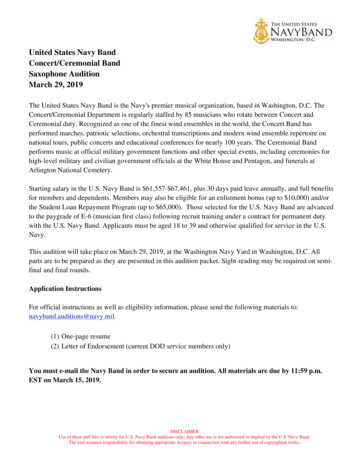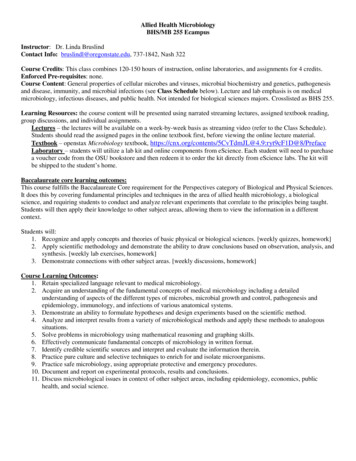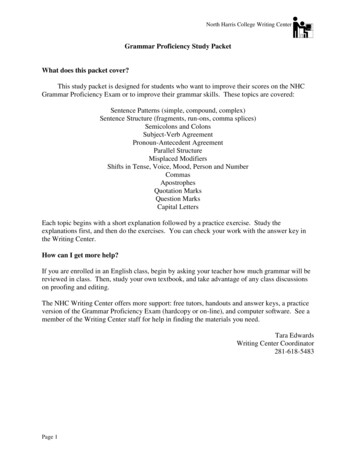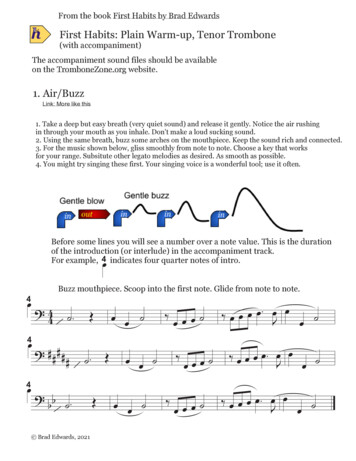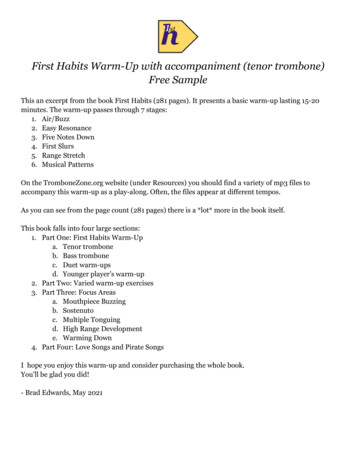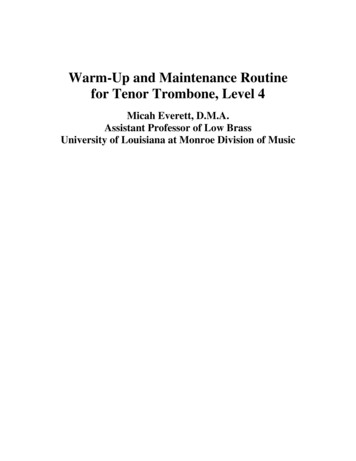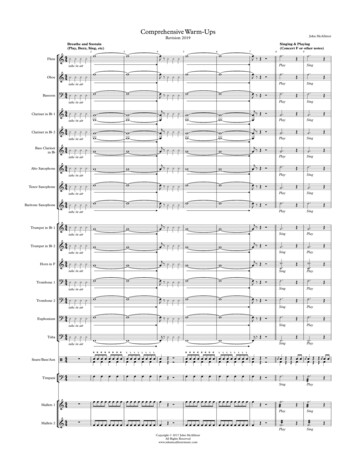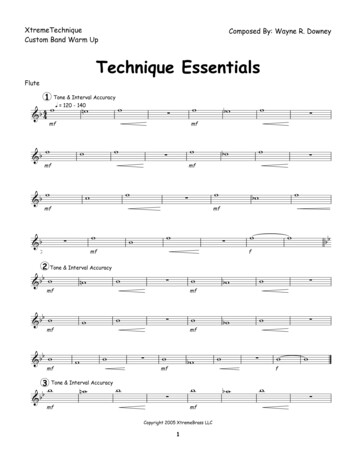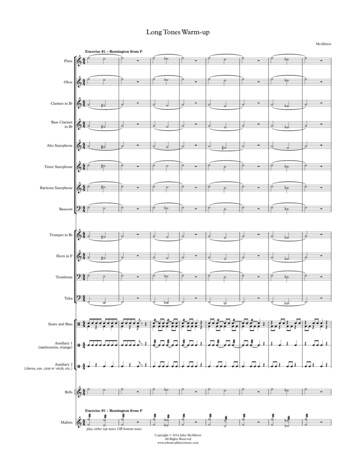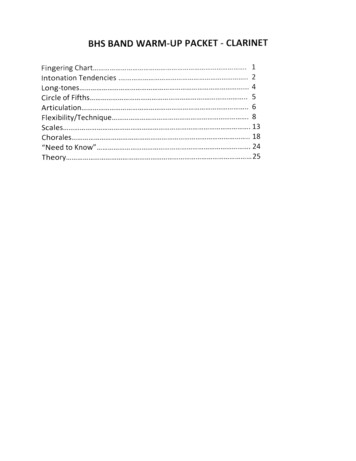
Transcription
BHS BAND WARM-UP PACKET CLARINETFingering ChartIntonation TendenciesLong-tonesCircle of les‘Need to Know”Theory.12456813182425
1B’ Clarinet Fingering ChartFP5I:!!4BCC U:a0G.IJLtA.A II.:05EI .F5F—:Laorora0000000G5A.Z j,i.AG5or!D1-.a0 G.:D—, 0-GI’a00A 000080000A5L.000Bo.80 �2G000Wt2ECPC D,o00F G’!:V820000a 000it!: it: V % or or ttII1: zjj7: I(4G0tA’A;:I2it100nC6 D E!tl 000GAF110:.aoaa0AA5 :4zZ2FB 0000 0 -i 2000D!4’: ‘2000:ii ig000,0BC-:a 0ia ‘itI a 1*0 ‘0lbaa ‘tIcaI00tbbiblidoraaittora0a00ill:2020
0. 0 0001000-0001000-0001000-0001000-0001000 1000l00 000l0000001000 100010000 oo{oo 000100 0001 o.0400010 SISC,SC,rC,rIOOtO OQQ:0ooo!c.I000IOSS0001095\.000(055L000 LI.0000’.I.000{SSi,000!Ø \0S01#Sse01rS01eOI105015551ooê i 0Dil.0 ! it0 . i S55515 iiI0l.4444IC.,SC)SrSSC,aIC,I-g-8. SSlSSSI.e. !. i sijisS.!.5.55.5II fl01!SrI01S3
922-fi9244.1 ‘01000 .0)0004 001 0oCC4 .olooo4 0)000 &JC)00 .Ol000 .,000:4 )000
çhTendencies&AdjstmentsClarinetF’ FlatS SharpV Veryl!2H Half hole(Notes not addressed aregenerafly acceptable)fUPitchTendencyAdjustmentFFNo1,2, 3,4 & RTFingeringAdjustmentFUse I & 4FFnoneSLTI & SiAdd 4, 5,643,vssUse A & S4 or3,4 and RPINoneSUse 3, 4, 5, 6and RPISSUse A & S4or I & 4SNonePossible shadingof left handhalf hole Ii:iShalfhole ISLTI. l/2H 1,2.35andRP4VFLTI, l.2,3,LP44,5,6page 15VFLTI, 1,2,4,5,6,RP4FLTI,2,4,5,RP4or LTI. i,4,RP4or LTI.RP4
‘4ClarinetØLT2oOQS4S3S2SILP3ILP1page 14
3êThe Tuning ProcessWood windspsp.ficcQIQi Play diatonically from top line F up to Bb three or four times. Tune the Bb Scentssharp. (Note: Bb on piccolo is not always the most centered note. If you find this to be true. tune to top lineF playing UP from 3rd space C three or four times. Again tune approximately 8 cents sharp.) Be aware thatmany piccolo and flute players tune with more air than needed. This pushes the pitch up considerably. Playwith what Emory Reinmington called ‘a conversational breath.’ This will give you a more accurate reading.Be aware of the head joint and its adjustment, as this has a severe influence on the pitch. (Note: Bb abovethe staff should be well centered. Use frequent checks to see if this note stays constant.)Oboe: Being aware of the problems that the reed and instrument present, it is still imperative that we becomeconsistent in our approach to tuning. Play diatonically from 1st space F up to 3rd tine Bb three or four times.The Bb should be slightly sharp. Then play diatonically from 3rd line Bb up to F three or four times. TheF, especially the fork fingering, will be slightly sharp. If you use the regular fingering for top line F, the pitchwill tend to be flat. (Note: A reed of approx. 70mm is recommended to achieve the desired pitch withoutsqueezing.) Constantly check 2nd space A and A above the staff as this is the most centered note on the horn.B.n: The instrument, reed and bocal have a great deal to do with the pitch of this instrument. Checkthe 2nd line Bb and 4th line F, playing to both of them diatonically from below three or four times. If thesenotes are not close to the required pitch immediately work with the bocals (size 00 to 4 from small to largeor sharp to flat) and the reed lengths. The reed should be 2-1/8” overall and a #2 bocal on a good instrumentshould work best. Also be aware of the distance the reed fits on to the bocal. Too much or too little will causethe instrument to play far enough out of tune so that accurate tuning will be impossible. It is important tonote that choosing a qualified student, instrument, reed and bocal will fend to make the pitch problemsless frustrating for you and your double reed players.Clarinet: Check 2nd line G and adjust the barrel (approx. 1/8 inch). Then check low C. If it is sharp, adjustthe middle joint. Finally check 3rd spaceC. If this note is also sharp, adjust the bell. (Note: If this ad)ustmentfurther flattens low F then disregard.) Once this is completed, play up to each note, diatonically, three orfour times to insure consistency. (Note: Most student clarinets are built sharp. This is why it is imperativeto secure an accurate reading on 2nd line G first.)First check 2nd line G. It should be very close to the centered pitch. Second checkG above the staff, This note should register slightly sharp. Play up to these notes diatonically, from 1), threeor four times. (Note: Top line F sharp is the best note to check for zero tolerance.)AJiQnd Ban Sax:Follow the same procedure as alto sax. Second line G should be almost perfect and G abovethe staff should be sharp. (Note: 3rd line B is the best note to check for zero tolerance.)ThnoLSIt is again noted that the quality of the instrument, reed, ligature and mouthpiece play a veryImportant part in the successful development of acceptable intonation.page 5
Clarinet in BBaldwin Band Standard WarmupsLong TonesBreathing!fz46B-flat OverlapSeparatePlayer 1F Concert Paynter]-13-IJIID Paynter (Descending)UjIF Paynter (Ascending).1 ,1J25--U22IB-flat Paynter (Descending)J19Player 3Player 2Player 1Player 2IIIPaynter (Skips)II
AppendixGC(a minor)(e minor)D(d minor)B(g minor)ACircleofFifths(c minor)(f sharp minor)A(f minor)ED(c sharp minor)G(b flat minor)(e flat minor)F (gsharp minor)W32CL
CCCCCCCIIIIIIIIIIIII11J1-j1J1I
Application xerctses ttrom MOuilK auver çuur, me vrripmeteSaxophonist. Glenmoore, PA: Northeastern Music Publishers)Spoken ExercisestotoIatoiutoiuatoletrtoer r r—tertattoeowr r r toeowtoer rtie—to—talr r I r r Ir r r r Ir r rlid-diedig-gier r r r rrr erat-tier r r r r r rr r rr r r I/
31:C.,)IIcIIIIII111111I!IIIIII-çII
6Warm-Up Set 1Option 1 (unison “lip slur” with brass)4cJIJi4-Y1,J3——ii J5—7J(JIJii1213Ii-4—4I14Option 2 (unison register study with brass)[eIr rle3r.IJI,U5JU—rr11Options 3, 4, & S (technical patterns with brass lip slurs)Articulation Patterns:11O14W32CLJ1331
4—-.—F::)
811/arrn Up Set 3Option 1(Unison“lip slur’ with brass)tOption 2 (unison register study with brass)Options 3, 4, & 5 (technical patternswith brass lip slurs)Articulation Patterns:24SjW32CLJ jJ678
WarmUp Set 4Option I (unison “Up slur” with brass)A.7—Option 2 (unisOn register study with brass)91ol4Options 3, 4, & 5 (technical patterns with brasslip slurs)0 Patterns:Articu1ajJ ffJJW32C
I.(jCCI)CCD--.4
0ICIIN
lbc )c.)-c.)c.)(
IL‘-II44IrII‘S(I!O0(D(ThCD
CCl)C)CCC)C’)[[[[I4ICcC-CC)C)Cl,CCC)C)CD
CHCIctIIcIri)H00i—
L--—w—r LzEZ22-Altoz-73j70j—-S: —U--7r::7:E4.--7 7—----——-s-——- --2- —U-———FzUZZZZUI--7—2--15UU-72-8ZU--JZ z2 2- TUUt7ZLzzzzzU—Z-7
LIUIHIHtr*HHIH1hi ‘HIHHH[jJ1SHHIf[LHHHHtlIHHfUHHflr05
0IiIi*fjILi h—i1Hd41I“:I--: :iiiiiLLIfjIIi*;i.H} HiiIiiiH-J-
CICItILHb4bIII(EI‘4‘44414444 I”4h4I44LI b1Ti[iiftI‘I
I.—iH‘t‘IIII tIJ1t
:4BAND INFO“NEED TO KNOW”Strategies for SMART practice:1.2.3.4.5.6.Play rhythms on one pitch first if difficultLook for patternsPlay in a comfortable range first (down an octave?)Isolate one challenge at a timeWork slow to fast (use a metronome)Build from the middleLogical Steps to Effective Intonation1. Listen for “beats”2. Make an adjustment; if beats get faster, try the opposite until the beats slow andeventually disappear.3. If you have to pinch to make the beats stop, make your instrument shorter4. If you have to relax to make the beats stop, make your instrument longer5. When you hear no beats while playing with your normal embouchure you are in tune!Ways and Steps to Listening1. If you hear yourself sticking out of the band’s sound you may be playing too loud. This isBALANCE. See below for info on the Pyramid of Sound.2. If you adjust your volume and still stick out of the band’s sound, adjust your posture,embouchure, and breath support to make your tone mesh better. This is BLEND. Thinkof putting your sound “inside” other voices.e.g. Alto’s try to fit “inside” the horn sound;Trumpets try to fit “inside” the tuba sound.3. If you adjust your volume and tone and still stick out of the band’s sound, you may beout of tune. This is INTONATION (see above).4. Always listen down to the lowest instrument, to the people on either side of you, and toyourself.The Pyramid of Sound (BALANCE)1. Higher voices are more easily heard than low voices; therefore to create a morebalanced sound, adjust all dynamics levels as follows.2. Low voices (tuba, low brass, tenor sax) should be strongest.play at or above the writtendynamic level3. Middle voices (alto, horn) are the next highest priority.play at or slightly below thewritten dynamic level4. High voices (trumpets, flute, clarinet) should be least prominent.play one level belowthe written dynamic level
Scale and Chord Related Theorywithin the range of an octave,which ascend or descend in a stepwise mannerA scale is a series of single notesin alphabetical order.stepWiSe manner, the note names will always beBecause scales are arranged in aa specific whole step/half stepThe notes within scales haveother.eachwithjgyiic relationshipmajor scale (half steps are between scale degreesC36th, andC natural minor scale (lower the 3rd,7th scale degrees a half step).-4and 7HwWIIIScale Degrees: 123TonicDominantHwWWI e%.I1I6th scale degrees a half step).CDEFGABC2Scale DeXrecs: 1GABC876543w nwwDPFCLeading ToneHwIntervals:876876543andC harmonic minor scale (tower the 3rdii4WwGABCDEF2Scale DeVees 1Intervals:HwwII /\rrni/\ rnC8).-HmtiAugiqtte4 &plmip.ishcdand descending lower the 7th, 6th,C melodic minor scale (ascending lower the 3rdtevaL*fronC-,-and 3rd scale degrees a half step).HWIn1Crr,,I,CDEFScaleD ree5 143211WWWwrGABC765HwwHWWWr-ir/\ r,rl/\ II8BAGF74S6EDC321tsr,:-CII.Intervals of the C major scale:Major 2ndMajor 3rdIjJPerfect 4thjPerfect 5thJJPerteLt OctaveMajor 7thMajor 6thJIons.C major triad (three note chord) in root position and inversiRoot PositionSecond TnversioriFirst InversionAFrom Bottom:root-third-fifthFrom Bottom:fifth-root-thirdFrom Bottom:third-fifth-rootBasic chord types constructed from C:cntial Vocabulary:MajorMinorDiminishedlower thirdlower third & fifthInterval the distance between two notesII-Half Step the closest interval between two notes-Whole Step an interval of two half steps-AugmentedSus 4,ise fifthfourth replaces thirdThird the distance of two adjacent lines or two adjacent spaces--Scale Degree a note’s classification according to its position in the scale-InameTonic the first note of a scale, the “key-note” from which the scale takes itsnormally resolve to the tonicDominant the fifth scale degree, chords built on this note are “dominant” and--cy is to ‘lead or rise to the tonicLeading Tone the seventh scale degree, It Is one half step below tonic and its tenden-W3ZPL
Clarinet: Check 2nd line G and adjust the barrel (approx. 1/8 inch). Then check low C. If it is sharp, adjust the middle joint. Finally check 3rd spaceC. If this note is also sharp, adjust the bell. (Note: If this ad)ustment further flattens low F then disregard.) Once this is completed, play up to each note, diatonically, three or
